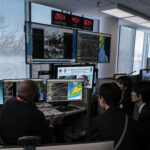The federal government is reconsidering whether sports fields and playgrounds made from ground-up tires could harm children’s health after some Environmental Protection Agency scientists raised concerns, documents show.
The EPA is concluding a limited study of air and surface samples at four fake-surface fields and playgrounds that use recycled tires — the same material used under the Obama family’s new play set at the White House.
Although the EPA for years has endorsed recycled-rubber surfaces as a means of decreasing playground injuries, its own scientists now have pointed to research suggesting potential hazards from repeated exposure to bits of shredded tire that can contain carcinogens and other chemicals, according to internal EPA documents.
The scientists cited gaps in scientific evidence, despite other reviews showing little or no health concern, and urged their superiors to conduct a broad health study to inform parents on kids’ safety.
Results from the agency’s limited study, which began last year, are expected within weeks.
“From everything I’ve been able to see, I’m not sure there’s an imminent hazard but it’s something we’re investigating,” said Michael Firestone, EPA’s head of children’s health protection. “It’s critical to take a look at all the data together.”
The government hasn’t decided whether broader testing is necessary.
Synthetic sports surfaces are easy on the bones and great for recycling, increasingly popular for their resiliency and for their weatherproof, low-maintenance qualities. But communities from New Jersey to Oregon have raised concerns about children touching, swallowing or inhaling lead, metals and chemicals like benzene, zinc and breathable particles from synthetic fields and play yards.
Last week, New York state officials said they found no significant health or environmental concerns in a study of leaching and breathable air above sports fields with so-called tire crumb, tiny rubber infill pellets that help anchor the synthetic grass blades. Other local studies have reached similar conclusions, examining artificial grass or tire crumb. Several have recommended additional research.
“If they really find it’s something toxic, I would be concerned,” said Alejandro Arroyo, a teacher watching his high school students from June Jordan School for Equity play soccer at San Francisco’s Crocker Amazon Park. The scent of tire rubber wafted over the busy, five-field complex as a dozen third-graders flopped onto artificial turf infused with gravel-sized, black rubber.
“We practice here, we eat lunch here,” Arroyo said. “Everybody does that. It’s a family park.”
Scrap tire mulch cushions the ground under the Obamas’ new play set at the White House. It was recommended by the National Recreation and Park Association, which relies on the industry’s safety assurances and recommendations by the Consumer Product Safety Commission for cushioning the impact of falls, said Richard Dolesh, public policy officer for the park association.
But New York City officials say their new sports fields no longer will use tire crumbs. Connecticut asked the EPA to study the matter shortly after the EPA’s Denver regional office recommended the same.
The EPA memo was sent to Washington from the Denver office in January 2008, saying that until more was known, the EPA should take a neutral stance instead of sanctioning recycled tires for play areas. The documents, obtained under the Freedom of Information Act, were provided to The Associated Press by the Public Employees for Environmental Responsibility, an advocacy group that objects to the EPA’s endorsement of using recycled tires without a broad scientific risk evaluation.
“It appears that there are valid reasons to take a broader perspective of all potential risks associated with crumb rubber” through a full-blown health study, said the memo from Assistant Regional Administrator Stephen Tuber.
Withdrawing the EPA’s endorsement would be premature, EPA spokesman Dale Kemery said.
“Nobody has the evidence at this point” to scientifically justify pulling back, he said.
The agency’s limited study won’t be definitive either, but along with studies in New Jersey, California, Connecticut and New York could help determine whether more research is needed.
The Synthetic Turf Council, an advocacy trade group, says laboratory-based claims of toxicity don’t reflect actual conditions.
“The science is clear that synthetic turf crumb rubber infill fields do not present a human health or environmental risk,” said Rick Doyle, president of the group.
The Consumer Product Safety Commission concluded last summer that synthetic fields pose no lead hazard for kids. It tested turf fibers for lead at a handful of fields. It did not examine chemicals in tire crumbs interspersed with the turf, or playgrounds where children handle mulch made from shredded tires.
A health advisory from the federal Centers for Disease Control and Prevention said older fields may be riskier for lead as wear kicks up turf dust. Not all turf fibers contain lead. The CDC urges eliminating all nonessential uses of lead, which can cause neurological damage in children.
Chemicals in recycled tires could vary by location because tire manufacturers differ, EPA scientists said.
Rep. Rosa DeLauro, D-Conn., who had criticized the CPSC’s effort and pressed the EPA for a comprehensive investigation, welcomed the environmental agency’s role.
“This is not about creating panic among parents or calling for the closure of fields made from synthetic turf,” she said in an e-mail. But people “need accurate answers about the safety and health effects of these fields to make the best possible decisions about where children and others are playing.”
Was this article valuable?
Here are more articles you may enjoy.

 California’s Snowpack Data Likely Signals Another Fire-Prone Summer
California’s Snowpack Data Likely Signals Another Fire-Prone Summer  What Claims Pros Must Know About Small Businesses’ Insurance Blind Spots
What Claims Pros Must Know About Small Businesses’ Insurance Blind Spots  State Farm Has Paid $2.5 Billion in Claims for LA Wildfires
State Farm Has Paid $2.5 Billion in Claims for LA Wildfires  US Weather Service Merges Units as Staffing Pressure Rises
US Weather Service Merges Units as Staffing Pressure Rises 